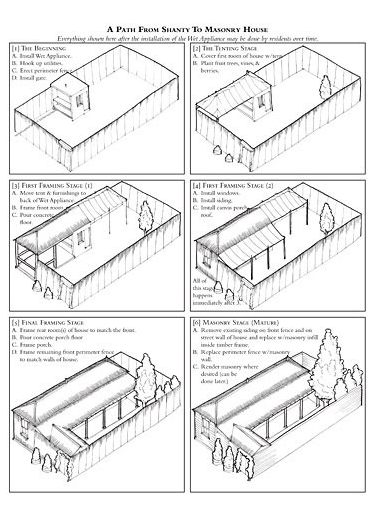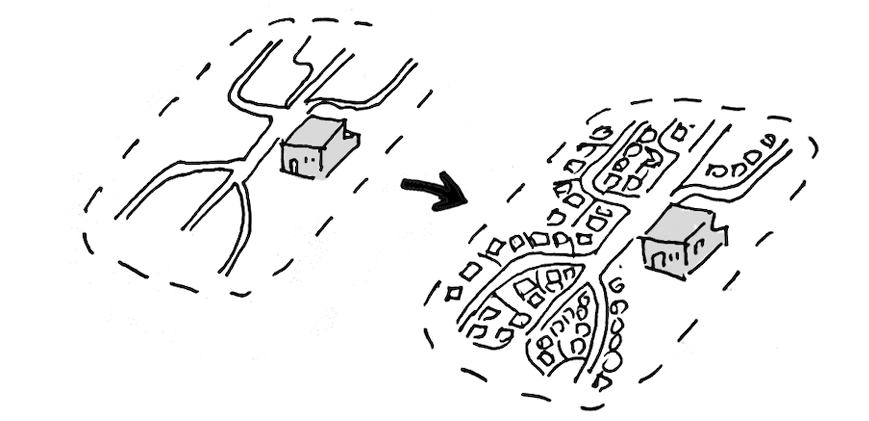…for a new development, a Slum Upgrade or Sprawl Retrofit, it is necessary to provide adequate utility services to guide growth.

__Problem-statement: It is very difficult to bring utilities to an informal settlement after it has already been developed. But it is very helpful to place utilities first into an area that is growing, in such a way that they will provide for more orderly development, sanitation and amenities.__
Discussion: Basic utilities like water, electricity and sewer are among the most urgent needs for informal settlements, but often among the least available. The stopgap methods that residents employ are often dangerous, unsanitary, or both. Fires created by ad hoc wiring are common, and sanitation is often poor, while the purity of water delivered by pipe is low, if it is available at all.
So many of the elements of informal settlements can be built by the people themselves: the homes, businesses, streetscape furnishings, and other elements.¹ Indeed, these constructions often express an inventiveness and even a beauty that is hard to match. Yet the one area where the people are least able to provide for themselves is the delivery of utilities.²

A proposal to bring in a utility core containing kitchen and bath components, allowing residents to self-build around it. Developed by The Prince’s Foundation and Steve Mouzon for an informal settlement in Jamaica.
Therefore, it is imperative that local institutions be created to provide utilities to informal settlements.³ Wherever possible, they need to be provided first, so that it is not necessary to tear out existing homes or streets, which can be disruptive and expensive. In addition, the utilities can be brought to points along the streets where homes may be built, so that individual owners can connect to them safely. One way of doing this is by providing a prefabricated hookup unit, containing the basic provisions for kitchen and bath plumbing as well as electric and other services. A version of this, known as a “wet appliance,” is shown on the next page. It allows homeowners to build onto this module with their own construction over time.
__Therefore: Provide the basic utilities that are needed for an informal settlement: water, sewer, electricity. Provide them as a framework on which to grow the community in later stages.__

Provide information about utilities at the Neighborhood Planning Center. Provide Entitlement Streamlining to residents…
notes
¹ The ability to safely create and repair elements of neighborhoods by people themselves, including utilities, is an important component of urban resilience, as noted in this report by the World Bank: https://www.worldbank.org/content/dam/photos/780x439/2016/oct-1/Urban-Resilience-Risks-738x440.png.
² For further discussion of the issues surrounding upgrading of informal settlements with utilities, see Del Mistro, R., & A. Hensher, D. (2009). Upgrading informal settlements in South Africa: Policy, rhetoric and what residents really value. Housing Studies, 24(3), 333-354.
³ These institutions need to assure that utilities are coordinated with an overall “green and grey infrastructure” system (see also Blue-Green Network). See for example the World Bank report, “Integrating Green and Gray Infrastructure for Water Security and Climate Resilience”, at https://www.worldbank.org/en/news/feature/2019/03/21/green-and-gray.
See more Informal Growth Patterns